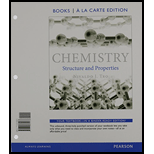
Which statement is true about matter?
a) Matter is particulate—it is composed of particles.
b) The structure of the particles that compose matter determines the properties of matter.
c) The particles that compose matter include atoms and molecules.
d) All of the above statements are true.
Interpretation: To determine the correct statement/s about the matter.
Concept introduction:
Matter can be defined as a substance that occupies any physical space and has inertia. Various types of particles having mass and size compose matter. The particles in the matter are electrons, protons and the neutron which are three sub-atomic particles. These particles combined to form atoms. Matter exist in different states also known as phases. The most common states of matter are solid, liquid and gas. Any element can have more than 1 or 3 states based on the pressure and temperature conditions.
Answer to Problem 1SAQ
Solution:
4. All the above statements are true.
Explanation of Solution
Matter is something that have mass and occupies space thus, it is made up of particles. It is made up of small particles arranged in a fashion that gives the matter its properties. The atoms of same or different elements group together to form molecules. The arrangement of atoms determines the behaviour of the molecules.
Thus, all the statements are correct.
Want to see more full solutions like this?
Chapter 1 Solutions
Chemistry: Structure and Properties, Books a la Carte Edition & Modified MasteringChemistry with Pearson eText -- ValuePack Access Card -- for Chemistry: Structure and Properties Package
- 1.23 Should the words theory and model be used interchangeably in the context of science? Defend your answer using information found in a web search.arrow_forwardIn Figure 1.5 you see macroscopic and particulate views of the element bromine. Which are the macroscopic views and which are the particulate views? Describe how the particulate views explain properties of this element related to the state of matter.arrow_forwardHow does an element differ from a compound? How are they similar?arrow_forward
- What is the chief factor that determines thephysical slateof a sample of matter?arrow_forwardClassify each of the following as an observation or a law: a. When water boils, small bubbles form in the liquid and rise rapidly to the surface. b. Two grams of hydrogen combine with 16 grams of oxygen to form 18 grams of water. c. Chlorine and sodium readily combine in a chemical reaction that emits much heat and light. d. The properties of elements vary periodically with the mass of their atoms.arrow_forwardWhich of the following are elements, and which are compounds? a NaOH; b BaCl2; c He; d Ag; e Fe2O3.arrow_forward
- To the best of your knowledge, classify each of the following as an element, a compound, or a mixture. If it is a mixture, classify it as homogeneous or heterogeneous. a. pure water b. copper wire c. graphite in a pencil d. oil and waterarrow_forwardMatter is everywhere around us. Make a list by name of fifteen different kinds of matter that you encounter every day. Your list should include (and label at least one example of each) the following: a solid, a liquid, a gas, an element, a compound, a homogenous mixture, a heterogeneous mixture, and a pure substance.arrow_forwardClassify each of the following as an element, a compound, or a mixture: (a) copper (b) water (c) nitrogen (d) sulfur (e) air (f) sucrose (g) a substance composed of molecules each of which contains two iodine atoms (h) gasolinearrow_forward
- Consider the sample of matter in the illustration below. Answer each question independently and explain your answers. a Is the sample homogenous or heterogeneous? b Is the sample a pure substance or a mixture? c Are the particles elements or compounds? d Is the sample a gas, a liquid, or a solid?arrow_forwardRefer to Chemistry Around Us 1.2 and explain what is meant by the following statement: All matter contains chemicals.arrow_forwardThe following pairs of substances represent heterogeneous mixtures. For each pair, describe the steps you would follow to separate the components and collect them. a. wood sawdust and sand b. sugar and sand c. iron filings and sand d. sand soaked with oilarrow_forward
- Chemistry: Matter and ChangeChemistryISBN:9780078746376Author:Dinah Zike, Laurel Dingrando, Nicholas Hainen, Cheryl WistromPublisher:Glencoe/McGraw-Hill School Pub Co
 Chemistry for Engineering StudentsChemistryISBN:9781337398909Author:Lawrence S. Brown, Tom HolmePublisher:Cengage Learning
Chemistry for Engineering StudentsChemistryISBN:9781337398909Author:Lawrence S. Brown, Tom HolmePublisher:Cengage Learning Chemistry & Chemical ReactivityChemistryISBN:9781133949640Author:John C. Kotz, Paul M. Treichel, John Townsend, David TreichelPublisher:Cengage Learning
Chemistry & Chemical ReactivityChemistryISBN:9781133949640Author:John C. Kotz, Paul M. Treichel, John Townsend, David TreichelPublisher:Cengage Learning  Chemistry & Chemical ReactivityChemistryISBN:9781337399074Author:John C. Kotz, Paul M. Treichel, John Townsend, David TreichelPublisher:Cengage Learning
Chemistry & Chemical ReactivityChemistryISBN:9781337399074Author:John C. Kotz, Paul M. Treichel, John Townsend, David TreichelPublisher:Cengage Learning
 Chemistry by OpenStax (2015-05-04)ChemistryISBN:9781938168390Author:Klaus Theopold, Richard H Langley, Paul Flowers, William R. Robinson, Mark BlaserPublisher:OpenStax
Chemistry by OpenStax (2015-05-04)ChemistryISBN:9781938168390Author:Klaus Theopold, Richard H Langley, Paul Flowers, William R. Robinson, Mark BlaserPublisher:OpenStax





